By Edward A. Malone and Elizabeth M. Roberson
ABSTRACT
Purpose: In technical writing, the consistent use of the present subjunctive in mandative that-clauses can promote stylistic clarity by distinguishing the not-yet actualized from the already actualized. A grammar rule requires the use of the present subjunctive in such contexts. We tested a group of STEM majors at our university to see whether they were predisposed to use the present subjunctive in mandative that-clauses when they were composing new content or editing existing content.
Methods: We administered two versions of a performance-based elicitation test in eight writing classes: (1) a complete-the-sentence version, in which the mandative that-clause lacked a complete predicate, and (2) a fill-in-the-blank version, in which the mandative that-clause lacked only a verb phrase (i.e., simple predicate). The former required composing new content, while the latter required editing existing content.
Results: In the mandative that-clauses across both versions of the test, the present indicative was used in 51 percent of the responses, while the present subjunctive was used in 28 percent. The present subjunctive was used in 249 out of 720 responses (35 percent) on the complete-the-sentence version of the test, while it was used in 191 out of 828 responses (23 percent) on the fill-in-the-blank version.
Conclusions: The students used the mandative subjunctive frequently, but they used the mandative indicative more frequently. They were more likely to use the mandative subjunctive when they were generating complete predicates (applying the grammar rule subconsciously in composing/drafting) than when they were supplying only simple predicates (applying the grammar rule consciously in editing/revising).
Keywords: editing, grammar, style, clarity, consistency, verb mood
Practitioner’s Takeaway:
- The indiscriminate use of indicative and subjunctive verb forms in mandative that-clauses can result in inaccurate, unclear, or inconsistent writing.
- In most cases, technical writers and editors should use the subjunctive rather than the indicative or modal should in mandative that-clauses for American audiences.
- The gap between subconscious and conscious grammatical knowledge may interfere with competent revision and editing; closing that gap requires formal study of grammar.
INTRODUCTION
Decades ago, a technical editor who was well known in the STC community described the subjunctive as a relic—one of the “old forms” of “days of yore”—that was being replaced by the indicative in most contexts (Whittaker, 1977, p. 192). Her discussion reveals that she had an imperfect understanding of the subjunctive. She recognized correctly that “If I were you” is a subjunctive clause (an example of the so-called were-subjunctive), but she also incorrectly described the following sentence as subjunctive: “If the indicator light turned on, the machine would be . . . .” Nowhere in her discussion does she mention the present subjunctive. Her impression that the subjunctive is disappearing from the English language was based partly on her own inability to recognize it. As Einsohn and Schwartz (2019) state, “subjunctive forms are hard to spot” (p. 357).
The subjunctive stands out when be (one form of the present subjunctive) replaces is or are (present indicative forms) or when were (the only form of the past subjunctive) replaces was (a past indicative form). Subjunctive clichés such as so be it and as it were seem like oddities. Consider the following example: “If being careful means delays, then so be it. Such delays are precautions, as it were, and should be welcomed.” But the subjunctive is not always so conspicuous. The mandative subjunctive—a common form of the present subjunctive—is relatively inconspicuous when the verb is something other than be. Someone might say, “They’re demanding she resign immediately,” without ever realizing that resign is a subjunctive form. It is the mandative subjunctive—not the were-subjunctive—that is ubiquitous in American English.
Recommending, requesting, and proposing are important speech acts in technical, scientific, and business writing, and the mandative subjunctive is used at the sentence level to perform or report these speech acts through verbs such as insist, require, suggest, propose, stipulate, and request. As experts in the use of workplace language, technical writers and editors should be able to recognize and consciously use the mandative subjunctive. A technical writer should know how and why the meaning of He insisted they be first is different from the meaning of He insisted they are first, and a technical editor should understand why be submitted should not be changed to is submitted in the sentence “The agency requires that the application be submitted by no later than June 1.” A grammar rule (see Einsohn & Schwartz, 2019, p. 358) requires the use of the subjunctive form be submitted in this context because it emphasizes that the action has not yet been actualized (i.e., not yet happened).
A writer or editor can improve stylistic clarity by using the mandative subjunctive to reinforce the meaning of “not yet actualized.” Whereas the difference between “We propose that the project is finished” (indicative = actualized) and “We propose that the project be finished” (subjunctive = not yet actualized) is a difference in meaning, the difference between “The SHARE team asks that there is an EMS contact at each participating agency” (Welch, 2017, p. 1; original sentence, mandative indicative) and “The SHARE team asks that there be an EMS contact at each participating agency” (our revision, mandative subjunctive) is a matter of clarity. Our revision is clearly a reported directive, whereas the original sentence might be mistaken momentarily for a reported question. Did the writer mean if or why instead of that? In such constructions, when a subjunctive verb form is used, the mandative meaning is unambiguous: the action or condition has not yet been actualized. When an indicative verb form is used, the meaning “not yet actualized” is more difficult to extract from the context. For this reason, the mandative indicative is sometimes referred to as “the covert mandative” (Huddleston & Pullum, 2002, p. 995).
Likewise, a writer or editor can improve stylistic consistency by using subjunctive verb forms in all mandative that-clauses. In the sentence “It is imperative that she know the rules and follows them,” the two bolded verbs should be either knows and follows (indicative) or know and follow (subjunctive), but the latter set more clearly expresses the mandative meaning. The inconsistency in verb forms is easy to detect in this example because the two verbs are close together, but sometimes they are far apart even in the same that-clause. Moreover, as we will show, it is not uncommon for a writer to use several mandative that-clauses in a short procedural document and shift unwittingly between subjunctive and indicative forms. As editors and teachers, we advocate for stylistic consistency because it usually enhances communication by reducing the reader’s interpretive burden.
The prevalence of the mandative subjunctive in American English is well established in the literature. For example, in a recent corpus-based study of mandative clauses of various types (e.g., subjunctive, indicative, modal), Waller (2017) found that the use of the mandative subjunctive was greater in 2006 than in 1931 in both American English (AmE) and British English (BrE). In mandative clauses within the AmE corpora, the subjunctive variant was used 56 percent of the time in 1931, 76.9 percent in 1961, 72.8 percent in 1992, and 61.2 percent in 2006. In mandative clauses within the BrE corpora, the subjunctive variant was used 13 percent of the time in 1931, 11.9 percent in 1961, 27.7 percent in 1991, and 28.5 percent in 2006 (Waller, 2017, pp. 241, 283). These findings suggest that the mandative subjunctive is far more common in AmE than in BrE and that the subjunctive has long been the dominant mandative variant in AmE. In present-day AmE, the mandative subjunctive is “frequently met with” (Kjellmer, 2009, p. 246).
Because we believe that the use of the present subjunctive in mandative that-clauses promotes semantic accuracy as well as stylistic clarity and consistency in technical writing, we conducted an experiment to determine whether our STEM college students—future subject matter experts and writers in the workplace—would use the mandative subjunctive in the prescribed way. Our research questions were influenced by previous studies of the mandative subjunctive as well as discussions of the subjunctive mood in technical communication textbooks and handbooks:
R1. How often will the students use the mandative subjunctive in test sentences containing mandative trigger words? (We wanted to see whether they are predisposed to follow the grammar rule of using the present subjunctive in a mandative that-clause.)
R2. Will they use the mandative subjunctive more often in drafting/composing (i.e., generating the complete predicate of a mandative that-clause) or revising/editing (i.e., supplying the simple predicate in an otherwise complete that-clause)?
To answer these questions, we constructed and administered two versions of an elicitation test: (1) complete the sentence, in which the mandative that-clause lacked a complete predicate, and (2) fill in the blank, in which the mandative that-clause lacked only a verb phrase or simple predicate. In our experience as writers and editors, supplying a word missing from someone else’s sentence is editing, whereas composing a complete predicate (e.g., deciding what to say about a given subject) is generating new content or composing. Contrast “It is vital [trigger word] that the user ______ all procedures” (fill in the blank with a simple predicate) and “It is vital that the user . . . ” (complete the sentence with a complete predicate). The former offers very limited options, whereas the latter is comparatively wide open.
We found that, across both versions of the test, the following mandative variants were prevalent in the responses: the indicative (used in 51 percent of the responses), the subjunctive (28 percent), and modals (at least 10 percent). In other words, in more than two-thirds of the responses, the students did not follow the prescriptive rule of using the present subjunctive in a mandative that-clause. However, they were more likely to use a subjunctive verb form when they were composing (generating the complete predicate of a clause) rather than editing/revising (merely plugging in a missing verb). The subjunctive was used in 35 percent of the responses on the complete-the-sentence version of the test and 23 percent on the fill-in-the-blank version. In two of the four classes taking the complete-the-sentence version, the subjunctive was the dominant mandative variant in responses. More than 80 percent of the students in our sample used the present subjunctive in at least one response.
The dominance of the mandative indicative in our sample challenges the commonly held assumption that the mandative indicative is a Briticism (e.g., Algeo, 2006) and suggests that, after graduation, our students will use the mandative indicative in workplace writing in spite of the ambiguities it can create. The frequency of the mandative subjunctive in our sample supports the often-repeated claim that the mandative subjunctive is in wide use by Americans (e.g., Hundt, 2018) and suggests that our students will likely shift inconsistently between mandative indicative and subjunctive forms in workplace writing. In an age when instruction in grammar is no longer emphasized in U.S. high schools and colleges, few writers and editors learn about the mandative subjunctive, and yet it should not be ignored by writers in revising text, editors in correcting and improving text, and instructors in evaluating writing.
The decline in our students’ use of the subjunctive when they were editing/revising as opposed to composing points to a gap between their conscious and subconscious knowledge of grammar. The expansive repertoire of grammar rules that the students have internalized from experience and use subconsciously in composing (performance) may be hampered by the limited repertoire of school-learned rules that they apply consciously in revising and editing (analysis). This gap between conscious and subconscious knowledge of grammar has implications for writing, editing, and the teaching of writing because grammatical constructions used effectively in spontaneous writing may be “corrected” with less effective constructions in revising and editing.
A Brief Tutorial on the Mandative Subjunctive
Verb mood reflects the communicator’s attitude toward the content of his or her utterance—whether that content is regarded as real (factual, already actualized) or unreal (counterfactual, hypothetical, not yet actualized).[1] In traditional grammar, English had three inflectional moods: the indicative (real), the imperative (unreal), and the subjunctive (unreal). Few contemporary grammarians accept this traditional paradigm, but many grammarians still regard the subjunctive as an inflectional mood in English.[2] (See Appendix A for a brief explanation of how the understanding of verb mood in English has evolved from traditional grammar to contemporary linguistics.)
The subjunctive mood in English can be divided into two main types: the past subjunctive, also called the were-subjunctive, and the present subjunctive, including the mandative subjunctive (Depraetere & Reed, 2006; Waller, 2017). These types are past and present in appearance, but not necessarily in meaning. The present subjunctive, for example, can refer to past, present, or future time: “The agency requests/asked/will insist that the application be submitted on time.” Because we are concerned specifically with the present subjunctive in mandative that-clauses, we will forgo a detailed discussion of the past or were-subjunctive.
In form, the present subjunctive and present indicative may be distinct in some contexts and non-distinct in others. For example, “It is important that each user have the same experience” (present subjunctive) is distinct from “It is important that each user has the same experience” (present indicative), but “It is important that I/you/they have the same experience” (present subjunctive) is identical to “It is important that I/you/they have the same experience” (present indicative). The latter set is said to be “non-distinct.” In Table 1, we have bolded the indicative and subjunctive forms where they are different. Note that, even when the indicative and subjunctive are non-distinct in the affirmative, they are distinct in the negative: “It is important that they not have the same experience” (present subjunctive) versus “It is important that they do not have the same experience” (present indicative).
One type of present subjunctive is the formulaic, so called because the verb is used in a set phrase or cliché (Quirk, Greenbaum, Leech, & Svartvik, 1985, pp. 157–158). Although subjunctive verb forms are usually located in subordinate clauses in present-day English, an archaic feature of these set phrases is that the subjunctive form is often (though not always) located in a main clause: Far be it from me to . . . (indicative: it is far), God bless you! (indicative: God blesses), If it please the court, . . . (indicative: it pleases), Perish the thought! (indicative: The thought perishes), etc. There are far more examples of the present formulaic subjunctive (e.g., if need be) than the past formulaic subjunctive (e.g., as it were).
Outside of these set phrases, the present subjunctive form is sometimes found in conditional clauses introduced by if, on condition that, provided that, unless, in case, and whether; adversative clauses introduced by lest and for fear that; and purposive clauses introduced by so that and in order that (Huddleston & Pullum, 2002; Waller, 2017). The following sentence is an example of a conditional clause with subjunctive be: “Turning up evidence of aliens on far-off exoplanets—be they mats of bacteria or grazing behemoths—will require giant space telescopes, exotic technology and a dose of good luck” (NASA, 2016). Note that the subject and verb (whether they be) are inverted (be they) when whether is omitted. The present subjunctive may also be used after would rather (I’d rather it be you) and high time (It’s high time they be told).
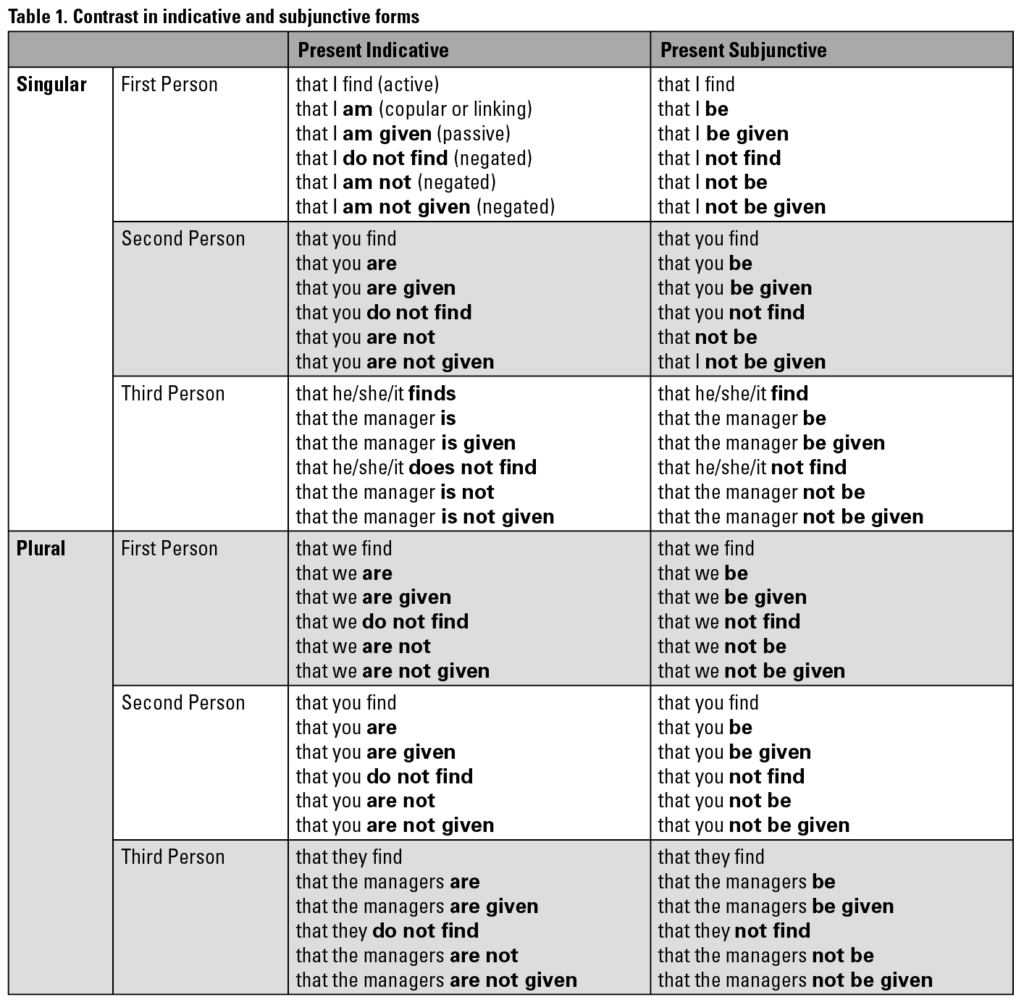
A common type of present subjunctive in American English is the mandative subjunctive. In both formal and informal contexts, Americans use the present subjunctive in sentences that express a demand, recommendation, proposal, resolution, or requirement. They use it in at least three sentence patterns corresponding to three classes of triggers: verbs, adjectives, and nouns.
- Noun or Pronoun + Verb + That-Clause (e.g., The policy requires that each worker wear [not the indicative wears] a mask)
- It + Verb + Adjective + That-Clause (e.g., It is crucial that all parties be [not the indicative are] present at the hearing)
- Noun + Verb + That-Clause (e.g., The request was that each person be included [not the indicative is included] in the final count)
That there are three classes of triggers is well established in the literature (Quirk, Greenbaum, Leech, & Svartvik, 1985; Huddleston & Pullum, 2002; Waller, 2017).
The main clause in one of these sentences always includes either a suasive verb (i.e., a verb expressing a desire to effect a change) or a related adjective or noun that triggers the subjunctive in the following that-clause—e.g., The FDA ordered [suasive verb] that the statement be added [mandative subjunctive] to the warning label. A writer of British English would be far more likely to use should be added in this context than would a writer of American English (Algeo, 2006; Leech, Hundt, Mair, & Smith, 2009).
In Table 2, we present examples of the correct use of the mandative subjunctive in all three clausal patterns. We took the sentences from professional documents ranging from government web pages to meeting minutes to technical reports. In each example, we have bolded and annotated keywords.
In mandative that-clauses, which are the focus of our study, a writer typically has three options for a verb: present subjunctive, modal should, or present indicative. The present subjunctive (the so-called mandative subjunctive) is said to be characteristic of American English, whereas a verb phrase containing should (the so-called mandative should) is said to be characteristic of British English. Although the present indicative is also an option for mandative that-clauses, a prescriptive grammarian would regard it as a mistake, yet the mandative indicative is found in both American and British English, though apparently with greater acceptability in the latter.[3]
Except for the mandative should, modals are often out of place in mandative that-clauses. The use of must in a sentence such as “I require/request/recommend that you must finish the job” is either redundant or contradictory. The use of can, may, or might in the same sentence would be confusing—e.g., “I require that you might finish the job.” A sentence such as “You must finish the job” may express a mandate, but it is not a mandative construction because it lacks the characteristic syntax and trigger word such as require or imperative.[4] A sentence such as “It is imperative (for you) to finish the job” is a mandative construction with an infinitive, but it does not contain a that-clauses and therefore falls outside of the scope of our study. Nevertheless, such constructions are sometimes stylistically preferable to mandative that-clauses. For example, “I asked him to leave” is usually preferable to “I asked that he leave,” but “We request him to leave” is not preferable to “We request that he leave,” and “I insisted him to leave” is not an acceptable alternative to “I insisted he leave.”
In Table 3, we present examples of potentially ambiguous mandative that-clauses in technical writing, and we explain how they might be edited for stylistic clarity. In Table 4 and Appendix B, we present examples of mood shifting among mandative that-clauses and explain how those clauses might be edited for stylistic consistency.
THE MANDATIVE SUBJUNCTIVE IN TECHNICAL COMMUNICATION TEXTBOOKS AND HANDBOOKS
A few technical communication textbooks discuss the mandative subjunctive as part of a larger discussion of verb mood. For example, Burnett (2005, p. 246) devotes a full page to verb mood. She gives five examples of subjunctive-mood sentences, of which four feature the were-subjunctive and one features the far more common mandative subjunctive: “When children are hospitalized, we recommend that parents be with them.” She seems to suggest that this form of the subjunctive is used only for making recommendations. She claims that the subjunctive mood in general is “useful in correspondence and reports” but not in “process explanations” and “directions.” While this may be true of the were-subjunctive, it is not true of the mandative subjunctive, which is useful in both process explanations and directions (as we explain below).
Gong and Dragga (1995) devote nearly two pages to verb mood, including the subjunctive. They note that English still has two main types of subjunctive: “the that subjunctive” and “the were subjunctive” (p. 694). The former appears to be their name for the mandative subjunctive: “I recommend that he be fired” and “She asked that he come to visit.” Although a subjunctive that-clause does not have to be mandative (cf. Suppose that he were here now), nor does the word that have to be explicit in such a clause (cf. They insisted she leave), nevertheless the name “that subjunctive” has the advantage of being jargon free and easy to understand for the undergraduate readers of the textbook. Gong and Dragga (1995) also mention a third type: the formulaic subjunctive (which they call “familiar expressions”).
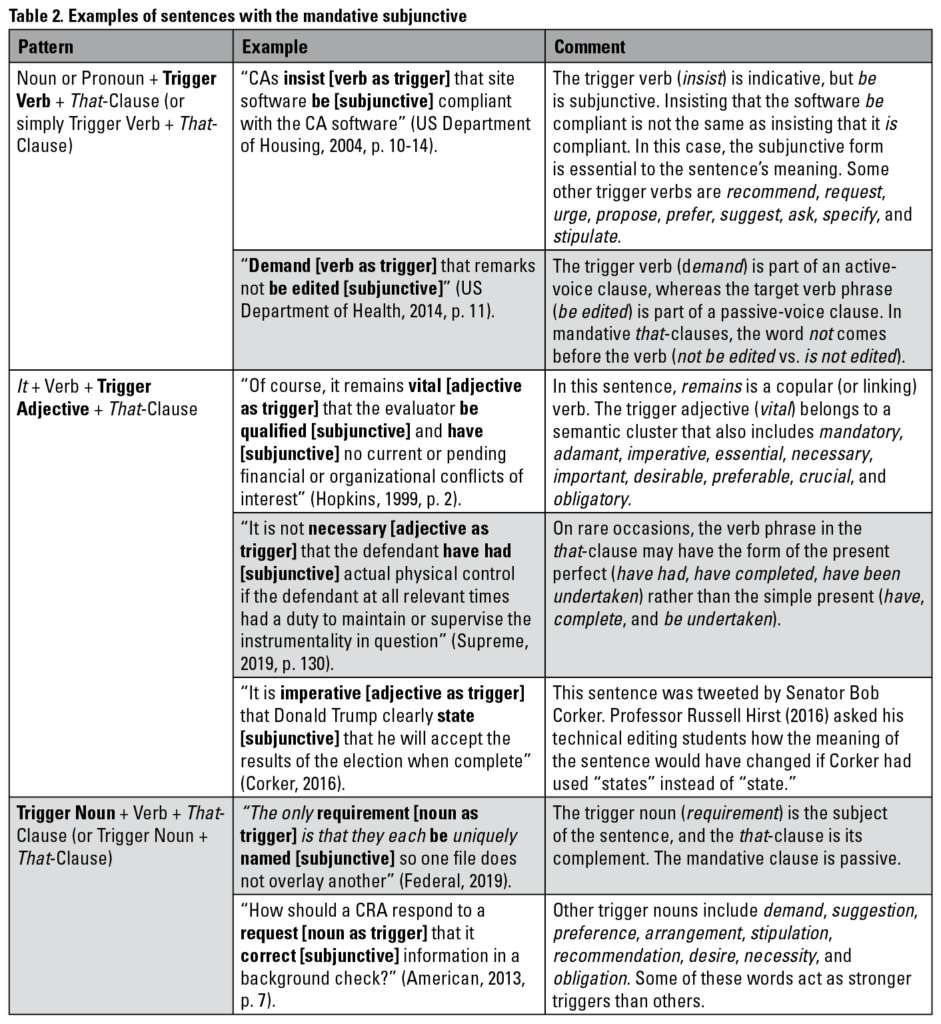
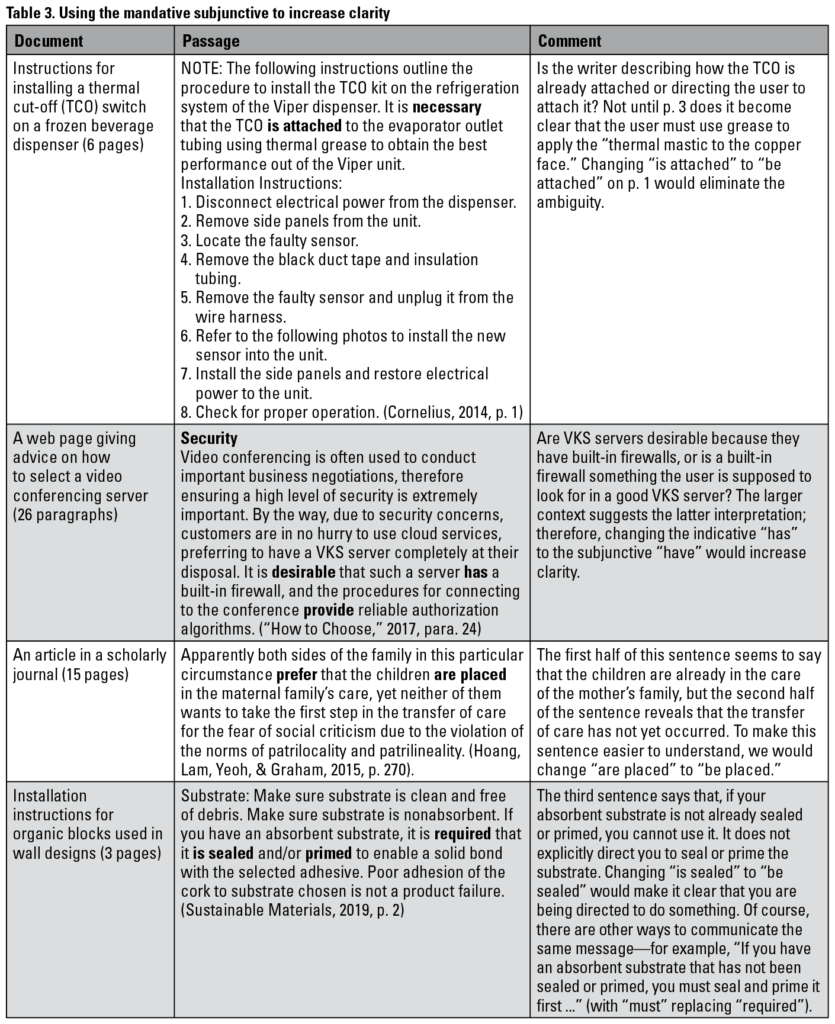
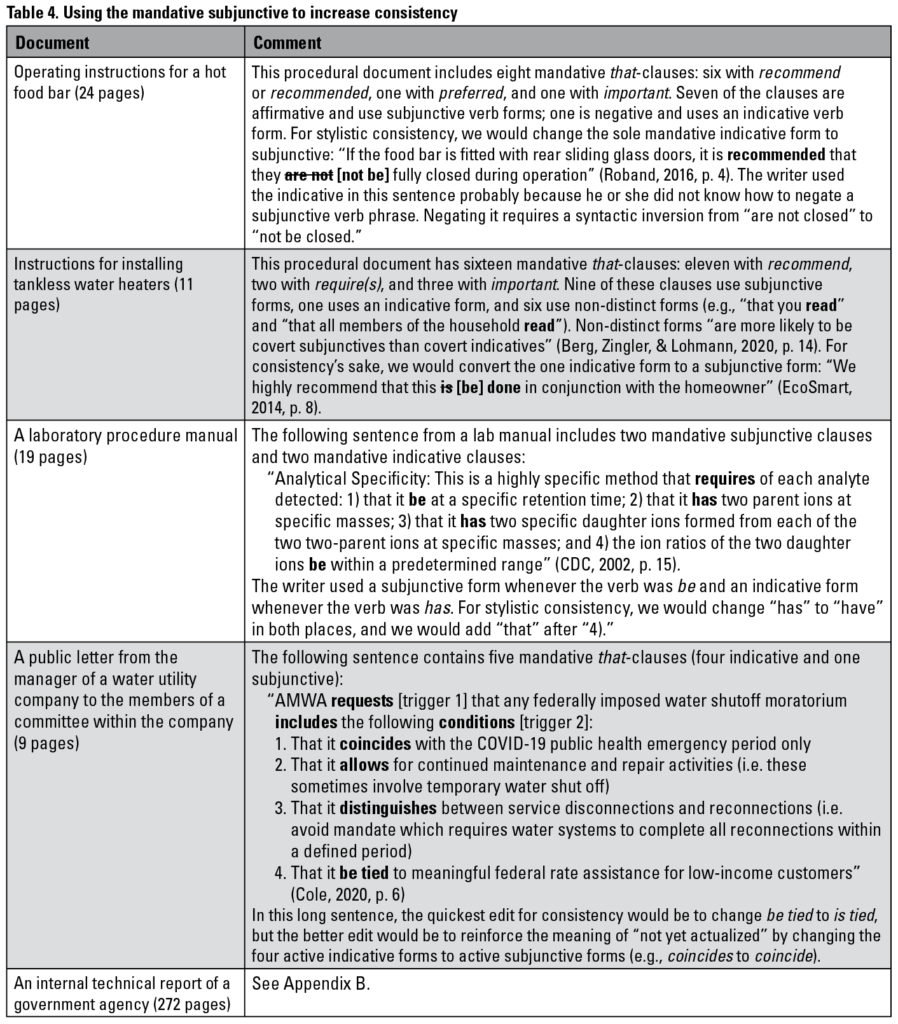
In their technical editing textbook, Cunningham, Malone, and Rothschild (2019) provide an extended discussion of both the were-subjunctive and the mandative subjunctive. They include example sentences and exercises as well as a conjugation table showing the subjunctive forms of three verbs, one regular and two irregular, including be. However, their discussion in general and the conjugation tables in particular are rooted in traditional grammar rather than contemporary linguistics.
Most technical communication textbooks use the mandative subjunctive in examples of memos, reports, proposals, etc., but offer no explanation of it. For example, in a section titled “Focusing Sentences on Action,” Anderson (2007, p. 265) revises the sentence “I would like to make a recommendation that the department hire two additional programmers” to read “I recommend that the department hire two additional programmers,” but he is concerned with reducing wordiness, not using the subjunctive mood. He does not explain why, in both sentences, the mandative subjunctive hire is used instead of the indicative hires. Anderson (2007) uses the mandative subjunctive in other examples on pages 168, 260, 316, and 549 and in scenarios on pages 58, 89, 94, 130, 443, and 595.
Markel (2010) explains the were-subjunctive and gives an example of it (p. 721), but he does not explain the far more common mandative subjunctive, yet the mandative subjunctive is used in some of his examples of technical writing:
- “advised that the company initiate” (p. 214)
- “recommend that more work . . . be done” (p. 222)
- “requires that the corresponding block lock bit be cleared” (p. 293)
- “recommend . . . that the pump be modified” and “that the pump be reinspected” (p. 464)
- “recommended Geo-Hydro Corporation use” (p. 498)
- “recommend that the company purchase” and “that . . . the company decide” (p. 517)
- “recommend that the gym try . . . and then revisit” (p. 519)
- “required that safety glasses be worn” (p. 523)
Without explanation, undergraduate readers are not likely to understand why the base form of the verb is being used in these passages.[5]
Pfeiffer and Adkins (2010) make no mention of the mandative subjunctive, but they use it in technical writing examples on pages 5, 11, 70, 230, 240, 242, 279, 290, 468, 546, and 641. The use of the mandative subjunctive in all these examples speaks to its ubiquitous presence and usefulness in technical writing.
Most technical communication handbooks explain and illustrate the mandative subjunctive in brief entries on verb mood, but they do not use the term mandative. Gurak and Hocks (2009, p. 492) include a page about verb mood, including the subjunctive. Two of their three examples of the subjunctive are sentences with if-clauses: a past subjunctive (were) and a present subjunctive (be). The third sentence is an example of the mandative subjunctive: “It is mandatory that he dress appropriately.” The authors do not explain why dress is grammatically correct in this sentence or whether using dresses would affect the meaning of the sentence. In our view, using dresses in this sentence would mean that he already dresses appropriately because it is required, whereas using dress would mean that he has not yet met the requirement that is being imposed.
In the 2nd edition of their handbook, Hargis and her IBM colleagues (Hargis et al., 2004, p. 199) align the indicative mood with the two DITA types—concept and reference—and the imperative mood with a third DITA type—task. They find no place in this scheme for the subjunctive mood, which they claim “is rarely appropriate” because “[a] subjunctive statement can confuse users and can be difficult to translate into languages that do not have the equivalent verb quality.” The IBM authors (Carey, Lanvi, & Longo, 2014) omit this discussion of verb moods from the 3rd edition of their handbook.
Although the association of the indicative and imperative moods with DITA types is clever and intriguing, Hargis et al. (2004) provide no evidence that the mandative subjunctive is “rarely appropriate” in a DITA concept, reference, or task component. In practice, writers use both the imperative and the mandative subjunctive to issue directives: the former directly, the latter indirectly. The directive “Attend [imperative] the meeting if you are a new employee” may be rephrased as “We ask that every new employee attend [mandative subjunctive] the meeting” or reported as “The policy requires that every new employee attend [mandative subjunctive] the meeting.” Therefore, the mandative subjunctive seems particularly relevant to procedural (or task-based) writing. Instructions often include mandative subjunctive sentences such as “We recommend that columns be installed in sequential order” (Rockwell Automation, 2019, p. 17) and “It is recommended that the water be allowed to cool before draining the tank” (Roband, 2016, p. 9).
A sentence with a mandative that-clause might be used in a DITA task. For example, a task titled “Shortening the control cord on a blind” might contain the following step:
<step>
<cmd>Adjust the cord to the desired height.
</cmd>
<info>If a child under 3 years old is living in the home, it is imperative that the cord be no more than 40 percent of the height of the blind. Children have been strangled by longer cords.</info>
</step>
In this case, the shift in grammatical mood changes the writer’s tone abruptly, emphasizing the gravity of the directive. It is an indirect directive—that is, a directive from an industry standard that the writer is passing along to the user.
Hargis et al. (2004) do not substantiate their claim that the subjunctive “can confuse users,” but we know that an indicative in a mandative that-clause can sometimes confuse readers. The non-mandative clause “It is only fitting that they are allowed to attend the meeting” (they are already allowed) has a different meaning from the mandative clause “It is only fitting that they be allowed to attend the meeting” (they are not yet allowed). Using the former in place of the latter might confuse some readers even if the context provides clarifying cues. For an American audience, even using “should” in a mandative clause might create ambiguity by interjecting the notion of moral obligation or duty: “It was agreed that negotiations should be suspended” (Was there merely agreement that it ought to be done, or was there agreement to do it?). An American audience may be less adept than a British audience at distinguishing should in the sense of obligation (the “deontic” should) from the so-called mandative (or putative or specialized) should (Algeo, 2006, p. 602; Waller, 2017, pp. 54–55).
Alred, Bursaw, and Oliu (2012, pp. 354–355) discuss the were-subjunctive and the mandative subjunctive in an entry about mood. In an “ESL Tips” box, they write, “In written and especially spoken English, the tendency increasingly is to use the indicative mood where the subjunctive traditionally has been used.” They describe the sentence “I requested that she shows up on time” as a “contemporary (informal)” version of the traditional (formal) sentence “I requested that she show up on time.” They give the following advice: “In professional writing, it is better to use the more traditional expressions.” We offer three observations about their example:
- Both shows up and show up will convey the same mandative meaning (not yet actualized), but show up will express that meaning more directly and clearly.
- Both shows up and show up are informal by comparison to arrive. The suggestion that there is a correlation between the indicative-subjunctive distinction in mandative clauses and an informal-formal register in style is worthy of study, but the mandative subjunctive is not associated exclusively with a formal style. Examples can readily be found in impromptu speech: “It’s important that she listen to us” or “I’d rather he not say anything” (in which rather seems to have the same meaning as the mandative trigger prefer).
- In most contexts, “I asked her to show up on time” would be stylistically preferable to “I requested that she show up on time”—if, indeed, the request was made directly to her and not indirectly by way of someone else.
Claiming that “careful writers” should pay attention to the subjunctive, Einsohn and Schwartz (2019, pp. 357–360) offer many examples of the present and past subjunctive. Although they never use the term mandative, they show their awareness of the mandative subjunctive when they write, “The subjunctive is required in that clauses following verbs of command, demand, suggestion, recommendation, wish, request, or necessity” (p. 358). To illustrate this rule, they give six examples of the mandative subjunctive and one example of the were-subjunctive after wish. Their inclusion of a were-subjunctive example suggests that their understanding of the mandative subjunctive is imperfect. They contrast the meanings of “It is important that the instructions be printed in bold type” (necessity) and “It is important that the instructions are printed in bold type” (fact), but they do not acknowledge the ambiguity created by using “are printed” to mean “be printed.” Writers routinely use indicative forms in mandative clauses at the expense of clarity and consistency.
Moreover, Einsohn and Schwartz (2019) do not consider other stylistic alternatives, such as “It is important to print the instructions in bold type.” This revision might seem like a viable option, but it actually alters the intended meaning slightly. The active-voice infinitive “to print” does not have an explicit subject; therefore, the reader will mentally insert you while reading it (“important for you to print”). By contrast, the original sentence uses passive voice (be printed) and does not say that the reader is supposed to print the instructions in bold. In fact, the meaning seems to be that someone else is supposed to do it (e.g., a printer). As a writer or editor, if you are looking for a way to avoid the mandative subjunctive entirely, you should keep in mind that each stylistic variation usually causes a shift in meaning, however subtle.
The authors of these handbooks considered the mandative subjunctive important enough to mention and illustrate, but most of them did not provide enough information for their audience to recognize it or use it correctly. For example, none of them discuss how to negate a subjunctive form: that they do not have becomes that they not have through the dropping of do-support and that it is not becomes that it not be through a syntactic inversion. Technical and scientific editors such as Underwood (2011) and Smith (2018) have argued that the mandative subjunctive is alive and well and that editors need to understand it. As we have been arguing in this article, using the mandative subjunctive prescriptively serves the goals of stylistic clarity and consistency as well as semantic accuracy. For an American audience, it is almost always a better stylistic choice than the mandative indicative.
METHODS
To investigate our students’ use of the mandative subjunctive, we administered an elicitation test in eight sections of the following courses at Missouri University of Science and Technology (Missouri S&T):
- One section of Composition I
- Four sections of Composition II
- Three sections of Technical Writing
We chose the students in these courses to be our subjects because they were primarily STEM majors taking writing courses. STEM majors usually become engineers and scientists who write in the workplace, and their writing is likely to be edited by peers, managers, or professional editors. These subjects were also convenient because we had ready access to them.
We received Institutional Review Board approval for our study in March 2016, conducted a pilot study in February 2017, and collected the data for the main study in March 2017. All tests were administered by co-author Roberson.
Development and Use of the Data Collection Instrument
Researchers studying the mandative subjunctive usually employ one of two research methods: either an experiment involving elicitation (e.g., Nichols, 1987; Peters, 1998; Whatley, 2014) or a systematic analysis of one or more corpora (e.g., Övergaard, 1995; Serpollet, 2001; Waller, 2017). Elicitation experiments generate artificial rather than natural data, but they offer affordances that a large textual corpus does not. For example, they enable a researcher to study a specific language behavior of a group of subjects at one point in time and to ensure that written responses are not edited by a third party. An elicitation test may be based on judgment (in which subjects express an opinion or preference) or performance (in which subjects compose or revise text) (Meyer & Nelson, 2006, pp. 99–100).
We used a performance elicitation test in our pilot study because we were studying the performance of a specific group of STEM majors and wanted to know how they would respond to triggers for the mandative subjunctive. Thus, for the pilot study, we developed our first research question: How often will the students use the mandative subjunctive in test sentences containing mandative trigger words? The elicitation test for the pilot study consisted of 9 prompts, such as the following:
-
- Mine workers must follow safety protocol.
State regulations mandate that each
mine worker .
-
- A healthcare provider should wear a face mask when attending to patients with tuberculosis.
Safety necessitates that a healthcare
provider .
- A healthcare provider should wear a face mask when attending to patients with tuberculosis.
After analyzing the results of the pilot test, we were concerned that our prompts (e.g., “Mine workers must follow safety protocol”) might have influenced the students’ choices of verb phrases in the that-clauses (e.g., “State regulations mandate that each mine worker [must follow safety protocol]”). Also, we decided that a second research question was necessary: Were the students more likely to use the mandative subjunctive in composing or editing? Thus, we revised the pilot study test to create two versions of the test:
- A complete-the-sentence version requiring the students to compose a complete predicate for a that-clause (e.g., “1. Safety demands that the driver _______________”).
- A fill-in-the-blank version requiring the students to supply a simple predicate—i.e., a missing verb phrase—in an otherwise complete that-clause (e.g., “10. The new policy mandates that every public meeting _________transparent”).
Each of the two test versions included twelve sentence prompts: four with trigger verbs, four with trigger adjectives, and four with trigger nouns.
In the main study, we administered the complete-the-sentence version in four classes and the fill-in-the-blank version in four classes. Both versions were prefaced with an informed consent statement and the following instructions: “Below are sentences similar to those you might find in an instruction manual, employee handbook, and so forth. Please complete each sentence in a manner that makes sense to you.”
Study Participants
As previously mentioned, the 134 study participants were all Missouri S&T students who completed the test in eight sections of three courses during the Spring 2017 semester. We used the class rosters provided by the university to identify students’ class levels and majors, but we could not distinguish test participants from nonparticipants in any class. Thus, in the last column of Table 5, the first number represents the number of students enrolled in the class, while the second number (in parentheses) represents the number of students who participated in the test. Students had the option to opt out of the test, and a few did so. Other students were absent on the day the test was administered.
As shown in Table 6, our sample included 22 distinct majors as well as five types of double majors. We counted the double majors separately from the single majors. A total of 125 out of 134 students (93 percent) were STEM majors.
Coding of Collected Data
Influenced by previous researchers (e.g., Övergaard, 1995; Whatley, 2014; Waller, 2017), we developed the following codes for our study: I for “indicative,” S for “subjunctive,” M for “modal,” O for “other,” and X for “left blank.” One of us, Malone, coded all the responses on the pilot test, and we hired a second coder, Emily Seals, to do the same. [6] After we had discussed the few responses on the pilot test that the two coders had disagreed about, we made changes to the coding scheme. The final version of the coding scheme is shown in Table 7.
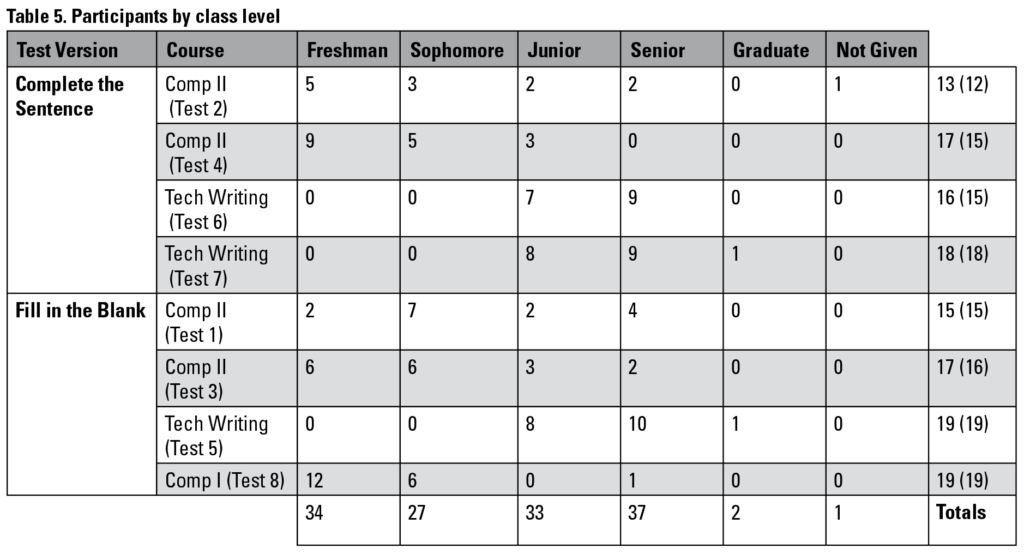 Working independently on the main test, the two coders gave the same codes to 1524 out of 1548 responses, for a simple agreement of 98.5 percent. The 24 disagreements had various causes. For example, on several responses, one or the other coder made a careless error, treating an obvious indicative verb form as subjunctive or vice versa. On several responses, one student wrote “[verb]s” rather than specifying the verb; one coder treated this as I while the other treated it as O. On a few responses, a student’s handwriting was illegible (= O) to one coder but legible to the other (I or S). One coder treated “miss read” as O while the other coder treated it as S. Each of these disagreements was later re-analyzed and resolved.
Working independently on the main test, the two coders gave the same codes to 1524 out of 1548 responses, for a simple agreement of 98.5 percent. The 24 disagreements had various causes. For example, on several responses, one or the other coder made a careless error, treating an obvious indicative verb form as subjunctive or vice versa. On several responses, one student wrote “[verb]s” rather than specifying the verb; one coder treated this as I while the other treated it as O. On a few responses, a student’s handwriting was illegible (= O) to one coder but legible to the other (I or S). One coder treated “miss read” as O while the other coder treated it as S. Each of these disagreements was later re-analyzed and resolved.
As stated previously, the two coders disagreed on 24 of the 1548 responses, and we evaluated and resolved each of those 24 disagreements. Our resolutions are reflected in the numbers we present in the results section.
RESULTS
Sixty students completed all or some of the twelve sentence prompts on the complete-the-sentence version of the test, for a total of 720 responses. Table 8 presents a classification of those responses according to their grammatical types (i.e., mandative variants). On sentence prompt 1, for example, 24 students out of 60 (or roughly 40 percent) used the indicative, 30 out of 60 (or roughly 50 percent) used the subjunctive, etc. We have rounded each percent to the nearest full number. Because modal verb phrases (that it must be, that he should leave, etc.) are sometimes classified as indicative, we remind the reader that we use the term indicative throughout this article to mean only non-modal indicatives (that it is, that he leaves, that they not be, etc.). We bolded the highest percent for each sentence prompt, and we included one illustrative response in each cell.
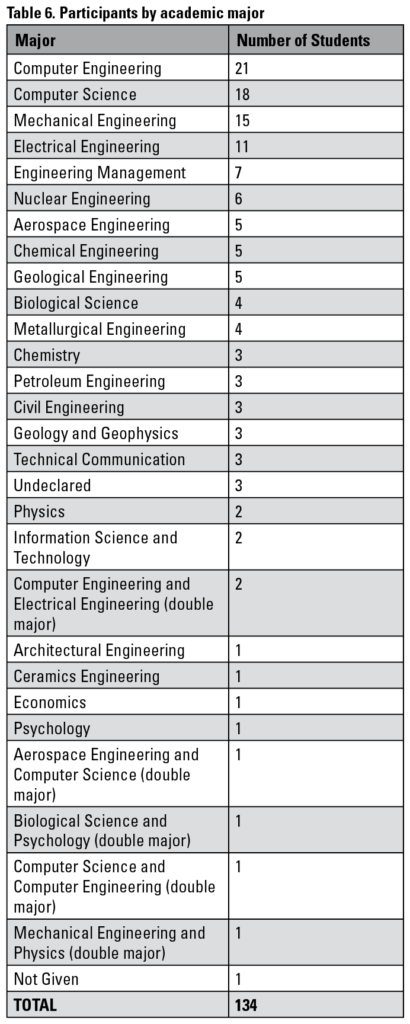
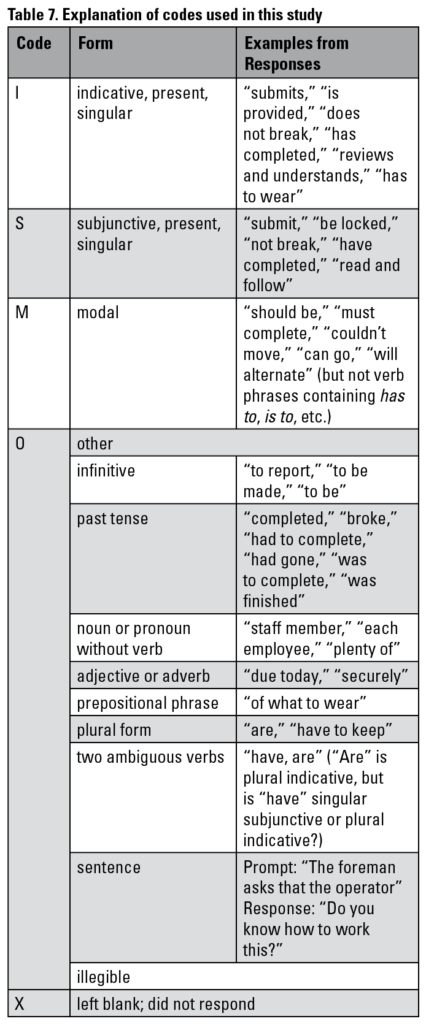
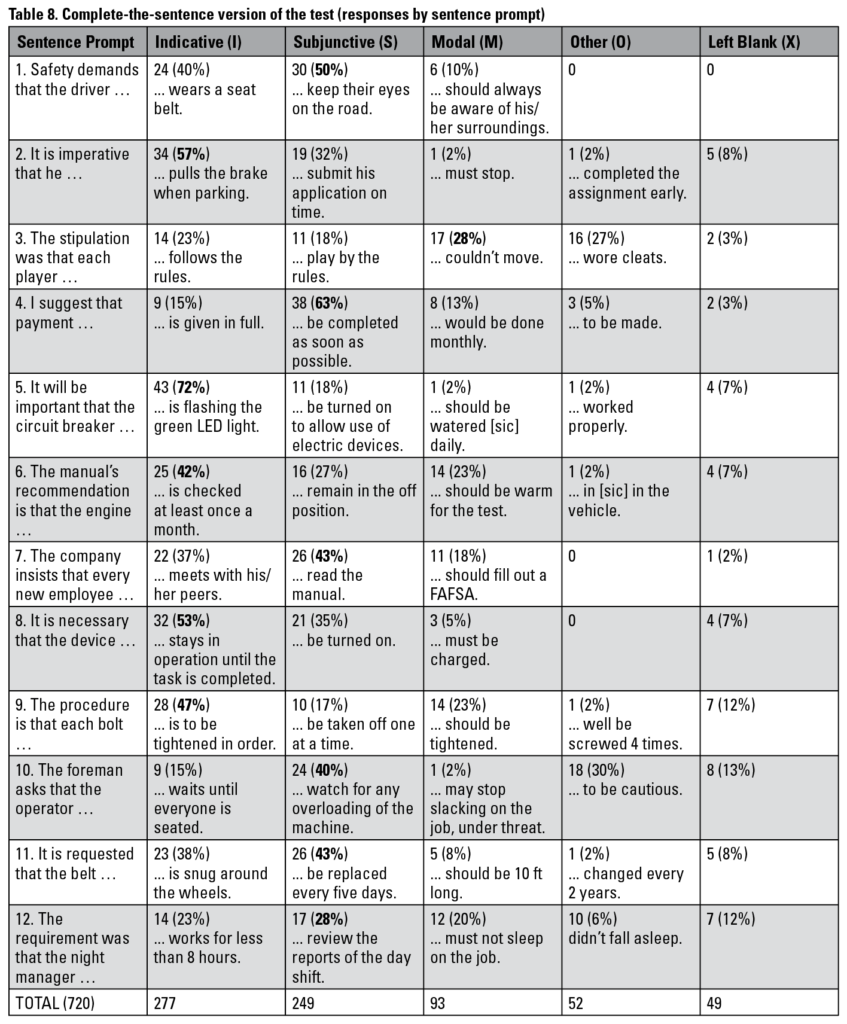 Table 8. Complete-the-sentence version of the test (responses by sentence prompt)
Table 8. Complete-the-sentence version of the test (responses by sentence prompt)
Sixty-nine students completed all or some of the twelve sentence prompts on the fill-in-the-blank version of the test, for a total of 828 responses. Table 9 presents a classification of those responses according to their grammatical types. The ellipsis in each prompt (stub column) represents the line on which the student wrote the verb form. We have rounded each percent to the nearest full number, bolded the highest percent for each sentence, and provided an illustrative response in each cell.
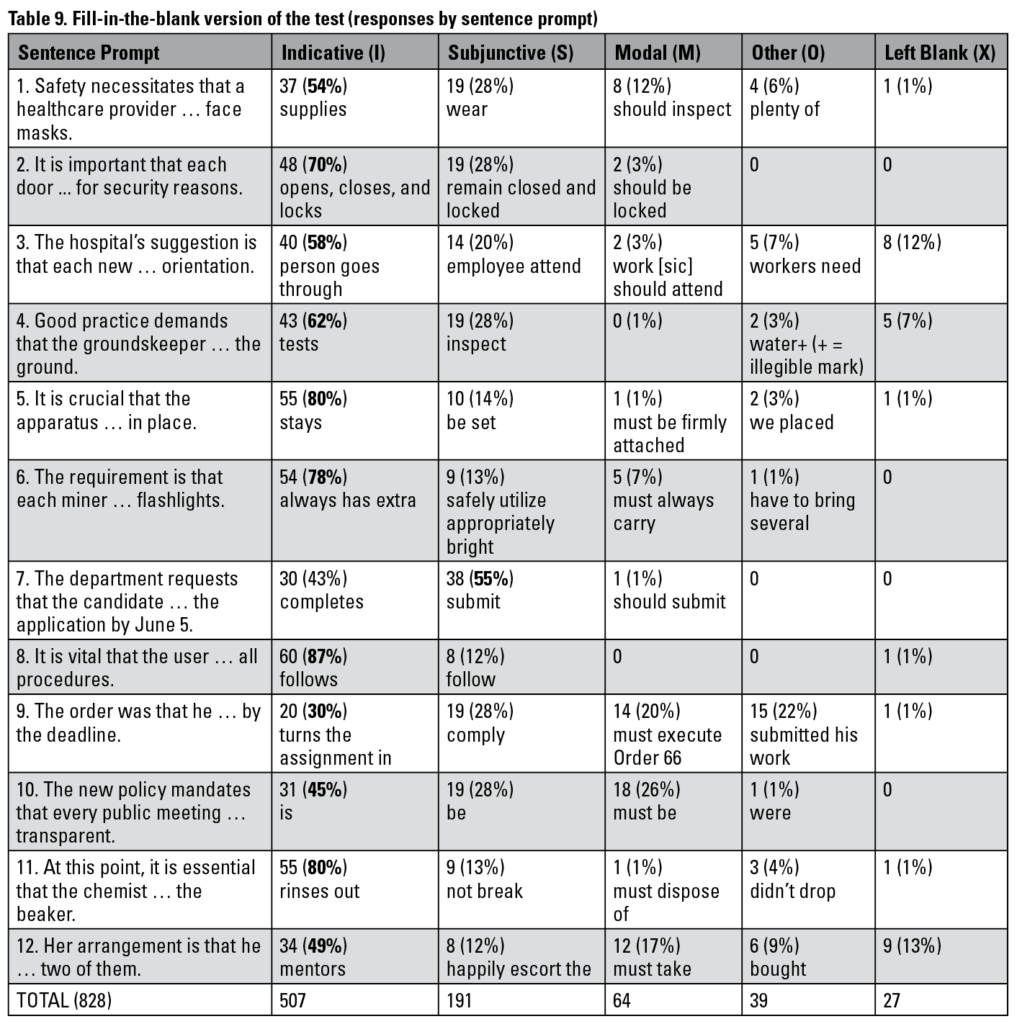 Tables 10 and 11 present a classification of the responses by course as well as by test version. We have rounded each percent to the nearest full number and bolded the highest percent for each course. These tables show that the mandative subjunctive was dominant in two of the four classes that took the complete-the-sentence version of the test, but it was not dominant in any of the four classes that took the fill-in-the-blank version of the test. As a reminder, the complete-the-sentence version of the test required constructing a clause as a response and corresponds to composing, whereas the fill-in-the-blank version of the test required inserting a verb phrase (i.e., one or more words) as a response and corresponds to editing or revising.
Tables 10 and 11 present a classification of the responses by course as well as by test version. We have rounded each percent to the nearest full number and bolded the highest percent for each course. These tables show that the mandative subjunctive was dominant in two of the four classes that took the complete-the-sentence version of the test, but it was not dominant in any of the four classes that took the fill-in-the-blank version of the test. As a reminder, the complete-the-sentence version of the test required constructing a clause as a response and corresponds to composing, whereas the fill-in-the-blank version of the test required inserting a verb phrase (i.e., one or more words) as a response and corresponds to editing or revising.
DISCUSSION
In this section, we discuss the results in light of our two research questions. In our interpretation of the results, we do not try to generalize beyond our own sample.
Research Question 1 (R1)
In R1, we asked, “How often will the students use the mandative subjunctive in test sentences containing mandative trigger words?” Many of our students followed the grammar rule of using the present subjunctive in mandative that-clauses, but even more of them used the present indicative in these clauses. As shown in Tables 10 and 11, the indicative was the dominant mandative variant across all responses, being used in 784 of the 1548 responses (51 percent). This result may be significant in its own right because the students in our study were mainly users of American English; therefore, their heavy use of the mandative indicative calls into question the prevailing view that “the indicative after suasive expressions is indeed a syntactic Briticism” and “is really only an alternative in BrE” (Leech, Hundt, Mair, & Smith, 2009, pp. 54, 57).


The students used the subjunctive much more frequently than modals, including must and should. Across both versions of the test, the subjunctive variant was used in 440 responses (28 percent), while the modal variant was used in just 157 responses (10 percent). Must was the most popular modal, with 69 occurrences, followed by should, with 58. The other modals in our sample—would, can, could, may, will, and shall—had fewer than 10 occurrences each. We surmise that our students do not use modals very naturally in mandative that-clauses. As mentioned previously, Americans do not use the mandative should as commonly and naturally as the British do (Algeo, 2006). Other modals occasionally work in mandative that-clauses, but more often they are bad fits: merely redundant rather than rhetorically emphatic (e.g., It is necessary that you must go) or contradictory or illogical (e.g., We ask that you must go). A modal may change a clause from mandative to non-mandative: It is important that you go with us (mandative) versus It is important that you can go with us (non-mandative).
On the complete-the-sentence version, the subjunctive was the dominant mandative variant used in one section of Composition II and one section of Technical Writing (see Table 10) as well as in responses to sentence prompts 1, 4, 7, 10, 11, and 12 (see Table 8)—i.e., half of the sentence prompts on that version of the test. In sentence prompt 4, “I suggest that payment . . . ,” the trigger word suggest elicited the subjunctive in 63 percent of the responses. The other strong trigger words were demands (50 percent), insists (43 percent), asks (40 percent), requested (43 percent), and requirement (28 percent).
Some students used the mandative subjunctive more than other students did. As shown in Table 12, 105 out of 129 students (81 percent) used the mandative subjunctive at least once in their responses. One student used the mandative subjunctive in responses to all twelve sentence prompts, whereas 24 students (19 percent) did not use the mandative subjunctive even once.
Research Question 2 (R2)
In R2, we asked, “Will they use the mandative subjunctive more often in drafting/composing (i.e., generating the complete predicate of a mandative that-clause) or revising/editing (i.e., supplying the simple predicate in an otherwise complete that-clause)?” Students in our sample were far more likely to use the mandative subjunctive when they had to complete a sentence with a complete predicate than when they had to fill in a blank with a simple predicate. However, it should be noted that, on the fill-in-the-blank version of the test, students sometimes wrote more than simple predicates in the blanks; some of their responses included adverbs (e.g., not, thoroughly) and other word classes (e.g., The requirement is that each miner has spare batteries for flashlights rather than just . . . each miner has flashlights).
Although the subjunctive was the dominant mandative variant in two of the four classes taking the complete-the-sentence version of the test, the indicative was the dominant variant in all four classes taking the fill-in-the-blank version. Students in the latter group were more than two times as likely to use the indicative than the subjunctive. Of course, there are many factors that might have contributed to this tendency—the specific trigger words that were used, the semantic contexts in which they were used, the specific students who took the test, etc.—but the fill-in-the-blank format of the test seems to have been a factor.
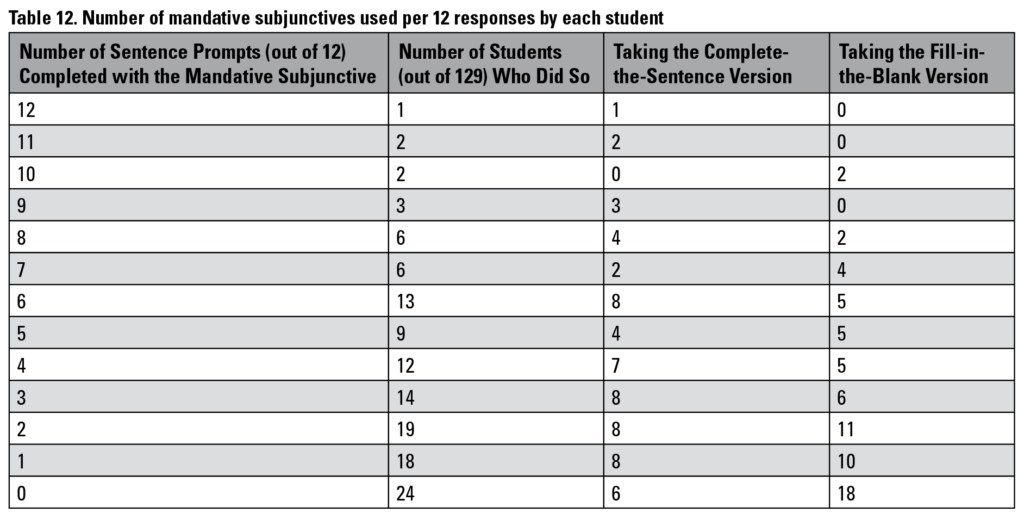
On the fill-in-the-blank test (Table 9), the subjunctive was the dominant mandative variant on only one sentence prompt (out of 12). In sentence prompt 7, “The department requests that the candidate . . . the application by June 5,” the trigger word requests elicited a subjunctive verb form in 55 percent of the responses. The indicative was the dominant mandative variant on all other sentence prompts.
We speculate that students were less likely to use the mandative subjunctive when they were supplying a verb phrase because they were focusing on a narrow semantic and syntactic context and may have been concerned with choosing the correct form of the verb to create subject-verb agreement in number. By contrast, students who completed the other version of our test were focusing on a larger semantic and syntactic context, and the meaning of the whole sentence may have demanded more of their attention. They were constructing a clause with a verb phrase in it rather than inserting a verb phrase into an existing clause. They were less likely to be thinking about subject-verb agreement rules.
If our speculation is correct, students may have been more likely to use the mandative subjunctive when they were accessing grammar rules subconsciously (i.e., from their linguistic experience as communicators as well as readers) rather than consciously (i.e., from a limited repertoire of school-learned rules about verb formation and use). Meyer and Nelson (2006) call attention to this phenomenon in their critique of elicitation tests: “As a consequence, [when asked whether they prefer a singular or plural verb in a given context], many individuals might not give a natural response, but try to determine what they might have been taught in school about subject-verb agreement” (p. 100).
CONCLUSION
Although the mandative subjunctive has received considerable attention in the published literature of linguistics, our study is the first to examine it for an audience of professional writers and editors as well as students and teachers of technical communication. We have focused on the use of the mandative subjunctive in professional writing, especially technical writing. Our study is also the first to compare the elicited use of the mandative subjunctive under two different procedures: finishing a sentence by composing a complete predicate for a mandative that-clause and filling in a simple predicate (i.e., a verb phrase) in an otherwise complete mandative that-clause. We suggest that the former procedure is analogous to writing or composing text (i.e., performance relying mainly on a large store of subconscious grammar rules), while the latter is analogous to revising or editing text (i.e., analysis relying mainly on a small store of conscious grammar rules).
Our study has shown that both the mandative indicative and mandative subjunctive were used frequently in the responses of the university STEM majors in our sample. Thus, the results of both our elicitation experiment and our analysis of workplace documents suggest that editors are likely to encounter both mandative variants in workplace writing for the foreseeable future, and the sentences in which they are used will need to be edited competently for semantic accuracy as well as stylistic clarity and consistency.
Some words such as insist, suggest, propose, fitting, and important may be followed by either a mandative or non-mandative that-clause (Huddleston & Pullum, 2002, pp. 995–996, 999). The indicative form must be used if the clause is non-mandative (I suggest that he knows the difference = he already knows it), and the subjunctive form must be used if the clause is mandative (I suggest that he know the difference = he needs to learn it). In these cases, the writer does not have the choice of using either an indicative or subjunctive verb form. A competent writer and editor must know which one is correct.
Other words such as demand, require, recommend, essential, and necessary may be followed only by a mandative that-clause. In these cases, the writer has a choice of using either an indicative or subjunctive form to convey the mandative meaning of “not yet actualized.” Contrast “They are recommending that everyone over 60 gets tested” and “They are recommending that everyone over 60 get tested.” The reader can extract the same mandative meaning from both, but the use of a subjunctive verb form reinforces the mandative meaning, thereby increasing clarity and reducing the interpretative burden on the reader. For this reason, in mandative clauses for American audiences, the present subjunctive is usually a better stylistic choice than either the present indicative or the modal should.
Like many other grammatical choices made in linguistic performance, our students’ use of the mandative subjunctive may have been largely subconscious and therefore an unwitting part of their grammatical repertoires as communicators. On the fill-in-the-blank version of the test, if students’ use of the subjunctive was inhibited by their conscious attempts to construct subject-verb agreement in number and person, then we have to ask the following questions:
- To what extent does a too-limited set of school-learned rules about grammar undermine effective revision and editing?
- How much grammatical awareness should professional writers and editors have?
- If they need more, how should they acquire it?
A technical writing service course is hardly the place to study grammar in depth. There are too many other things that must be covered in such a course. The mandative subjunctive might be taught in an advanced course on editing or stylistics in technical communication; barring that, it will remain one of the many language-related topics that dedicated writers and editors must study on their own, perhaps by reading articles such as this one. Technical communication handbooks can do their part by providing better explanations of the mandative subjunctive and similar grammar-related topics.
The use of the mandative subjunctive is mentioned and illustrated in some technical communication textbooks and most technical communication handbooks, and some of these sources explicitly recommend its use over other mandative variants. However, these sources generally do not provide enough information for readers to understand why the subjunctive is used in a sentence such as the following: “Tens of thousands of people rely on this aquifer for their water, and we are really concerned that it not be contaminated in any way and still be a viable drinking source for the city of Rapid City” (Project NEPA, 2019). We suspect that many seasoned technical communicators, including editors, are not fully cognizant of this grammatical construction in their reading and writing. One of our goals in this article has been to increase awareness and understanding of the mandative subjunctive by explaining and illustrating its uses and emphasizing its relevance to technical writing.
REFERENCES
Aarts, B. (2012). The subjunctive conundrum in English. Folia Linguistica, 46(1), 1–20.
Algeo, J. (2006). British or American English? A handbook of word and grammar patterns. Cambridge: Cambridge UP.
Alred, G. J., Bursaw, C. T., & Oliu, W. W. (2012). Handbook of technical writing (10th ed.). New York: St. Martin’s Press, 2012.
American Civil Liberties Union of Washington (ACLU). (2013). Guide to criminal records and employment in Washington State. Retrieved from https://web.archive.org/web/20191228022552/https://www.aclu-wa.org/file/99150/download?token=m4Hs9loV
Anderson, P. V. (2007). Technical communication: A reader-centered approach (6th ed). Boston: Thomson Wadsworth.
Auer, A. (2008). Lest the situation deteriorates: A study of lest as trigger of the inflectional subjunctive. In M. A. Locher & J. Strässler (Eds.), Standards and norms in the English language (pp. 149–173). Berlin: Mouton de Gruyter.
Berg, T., Zingler, T., & Lohmann, A. (2020). The range of linguistic units: Distance effect in English mandative subjunctive constructions. Journal of Linguistics, 56(2), 231–268. doi: https://doi.org/10.1017/S0022226719000124
Biehl, E. R., & Smith, D. D. (Eds). (1982, June). EDRO SARAP Research Technical Reports, vol. 6. Retrieved from https://web.archive.org/web/20210325015044/https://web.mst.edu/~malonee/edro-sarap.pdf
Burnett, R. (2005). Technical communication (6th ed.). Boston: Thomson Wadsworth.
Carey, M., Lanvi, M. M., & Longo, D. (2014). Developing quality technical information: A handbook for writers and editors (3rd ed.). Upper Saddle River, NJ: IBM Press.
CDC Environmental Health. (2002). Laboratory procedure manual 26: Phenolic metabolites of pesticides [in] urine. Retrieved from https://web.archive.org/web/20210318232807/https://wwwn.cdc.gov/nchs/data/nhanes/2001-2002/labmethods/l26pp_b_met_phenols.pdf
Cole, S. (2020, May 15). Letter from the Assistant General Manager of SCV Water to the Public Outreach and Legislation Committee. Retrieved from https://web.archive.org/web/20210324154935/https://yourscvwater.com/wp-content/uploads/2020/05/POL_Packet_052120.pdf
Collins, P., Borlongan, A. M., Lim, J., & Yao, X. (2014). The subjunctive mood in Phillipine English: A diachronic analysis. In S. E. Pfenninger, O. Timofeeva, A. C. Gardner, A. Honkapohja, M. Hundt, & D. Schreier (Eds.), Contact, variation, and change in the history of English (pp. 259–280). Amsterdam: John Benjamins.
Corker, B. [BobCorker]. (2016, October 19). It is imperative that Donald Trump clearly state that he will accept the results of the election when complete [Tweet]. Retrieved from https://web.archive.org/web/20200601030357if_/https://twitter.com/BobCorker/status/788948882956967939
Cornelius. (2014, April 7). Installation instructions [for] thermal cut-off (tco) switch kit (p/n 629096942) on Viper FCB dispensers. Retrieved from https://web.archive.org/web/20210325014711/https://web.mst.edu/~malonee/cor0750.pdf
Crawford, W. J. (2009). The mandative subjunctive. In G. Rohdenburg & J. Schluter (Eds.), One language, two grammars? Differences between British and American English (pp. 257–276). New York: Cambridge UP.
Cunningham, D. H., Malone, E. A., & Rothschild, J. M. (2019). Technical editing: An introduction to editing in the workplace. New York: Oxford UP.
Declerck, R. (2006). The grammar of the English tense system: A comprehensive analysis. Berlin: Walter de Gruyter.
Depraetere, I., & Reed, S. (2006). Mood and modality in English. In B. Aarts & A. McMahon (Eds.), The handbook of English linguistics (pp. 269–290). Oxford: Blackwell.
Deshors, S. C., & Gries, S. T. (2020). Mandative subjunctive versus should in world Englishes: A new take on an old alternation. Corpora, 15(2), 213–241.
EcoSmart. (2014). Installation instructions & home owners manual [for] Eco 36. Retrieved from https://web.archive.org/web/20181119091245/https://images.homedepotstatic.com/catalog/pdfImages/26/269c977c-1b81-4f22-bc8a-371e2e0c39ed.pdf
Einsohn, A., & Schwartz, M. (2019). The copyeditor’s handbook: A guide for book publishing and corporate communications (4th ed.). Oakland, CA: University of California Press.
Federal Communications Commission (FCC). (2019, June 11). ULS electronic batch filing. Retrieved from https://web.archive.org/web/20190907054515/https://www.fcc.gov/wireless/systems-utilities/uls-electronic-batch-filing
Gong, G., & Dragga, S. (1995). The writer’s repertoire. New York: Harper Collins.
Gurak, L. J., & Hocks, M. E. (2009). The technical communication handbook. New York: Pearson Education.
Hargis, G., Carey, M., Hernandez, A. K., Hughes, P., Longo, D., Rouiller, S., & Wilde, E. (2004). Developing quality technical information: A handbook for writers and editors (2nd ed.) Upper Saddle River, NJ: IBM Press.
Hirst, R. (2016, October 20). Imperative subjunctive (just a little pun there) [Blog post]. Retrieved from https://web.archive.org/web/20200601030105/https://russelhirst.wordpress.com/2016/10/20/imperative-subjunctive-just-a-little-pun-there/
Hoang, L. A., Lam, T., Yeoh, B. S. A., & Graham, E. (2015). Transnational migration, changing care arrangements and left-behind children’s responses in South-east Asia. Children’s Geographies, 13(3), 263–277. http://dx.doi.org/10.1080/14733285.2015.972653
Hopkins, A. (1999, February 9). Memorandum: List of integrity assessment evaluations for underground storage tanks—third edition. Retrieved from https://web.archive.org/web/20170707055329/https://www.epa.gov/sites/production/files/2014-03/documents/ialist3.pdf
How to choose a video conferencing server. (2017, April 7). Sudo Null IT News. Retrieved from https://web.archive.org/web/20210324145044/https://sudonull.com/post/71740-How-to-choose-
a-video-conferencing-server
Huddleston, R., & Pullum, G. K. (2002). The Cambridge grammar of the English language. Cambridge, UK: Cambridge UP.
Hundt, M. (2018). It is time that this (should) be studied across a broader range of Englishes: A global trip around mandative subjunctives. In S. C. Dehors (Ed.), Modeling world Englishes. Assessing the interplay of emancipation and globalization of ESL varieties (pp. 217–244). Amsterdam: John Benjamins Publishing.
Hundt, M., Hoffman, S., & Mukherjee, J. (2012). The hypothetical subjunctive in South Asian Englishes. English World-Wide, 33(2), 147–164.
Jespersen, O. (1965). The philosophy of grammar. New York: Norton. (Original work published 1924).
Kastronic, L., & Poplack, S. (2014). The (North) American English mandative subjunctive in the 21st century: Revival or remnant? University of Pennsylvania Working Papers in Linguistics, 20(2), 71–80.
Kjellmer, G. (2009). The revived subjunctive. In G. Rohdenburg & J. Schluter (Eds.), One language, two grammars? Differences between British and American English (pp. 246–256). New York: Cambridge UP.
Lass, R. (1999). Phonology and morphology. In R. Lass (Ed.), The Cambridge history of the English language. Volume 3: 1476–1776 (pp. 56–186). Cambridge: Cambridge UP.
Leech, G., Hundt, M., Mair, C., & Smith, N. (2009). Change in contemporary English: A grammatical study. Cambridge: Cambridge UP.
Markel, M. H. (2010). Technical communication (9th ed.). Boston: Bedford/St. Martin’s.
Markel, M. H., & Selber, S. A. (2021). Technical communication (13th ed.). Boston: Bedford/St. Martin’s.
Meyer, C. F., & Nelson, G. (2006). Data collection. In B. Aarts & A. McMahon (Eds.), The handbook of English linguistics (pp. 93–113). Oxford: Blackwell.
NASA. (2016). How do we find life? Retrieved from https://web.archive.org/web/20210325014939/https://web.mst.edu/~malonee/be-they-mats.jpeg
Nichols, A. E. (1987). The suasive subjunctive: Alive and well in the upper Midwest. American Speech, 62(2), 140–153.
Övergaard, G. (1995). The mandative subjunctive in American and British English in the 20th Century. Stockholm: Almqvist & Wiksell International
Peters, P. (1998). The survival of the subjunctive: Evidence of its use in Australia and elsewhere. English World-Wide, 19(1), 87–103.
Pfeiffer, W. S., & Adkins, K. E. (2010). Technical communication: A practical approach (7th ed.). Upper Saddle River, NJ: Prentice Hall.
Project NEPA. (2019, February 7). Court strikes down Edgeville uranium mine permit. Retrieved from https://web.archive.org/web/20200909111821/https://protectnepa.org/nrc-dewey-burdock-uranium-mining/
Quirk, R., Greenbaum, S., Leech, G., & Svartvik, J. (1985). A comprehensive grammar of the English language. New York: Longman.
Roband. (2016, September 2). Operating instructions [for] hot food bar. Retrieved from https://web.archive.org/web/20200416140558/https://www.roband.com.au/wp-content/uploads/2016/11/Hot-Foodbar-E-v7_C_Sv6-Operation.pdf
Rockwell Automation. Installation instructions / original instructions [for] Centerline 2500 low voltage motor control centers, Bulletin Number 2500, April 2019. Retrieved from https://web.archive.org/web/20201206015756/https://literature.rockwellautomation.com/idc/groups/literature/documents/in/2500-in001_-en-p.pdf
Schluter, J. (2009). The conditional subjunctive. In G. Rohdenburg & J. Schluter (Eds.), One language, two grammars? Differences between British and American English (pp. 277–305). New York: Cambridge UP.
Schneider, E. (2011). The subjunctive in Philippine English—An updated assessment. In M. L. S. Bautista (Ed.), Studies in Philippine English: Exploring the Philippine component of the International Corpus of English (pp. 159–173). Mandaluyong City: Anvil Publishing.
Serpollet, N. (2001). The mandative subjunctive in British English seems to be alive and kicking. . . . Is this due to the influence of American English? In Proceedings of the Corpus Linguistics 2001 Conference (pp. 531–542). Lancaster, UK: University Centre for Computer Corpus Research on Language.
Smith, B. (2018, June 30). Verb mood—The subjunctive mood. Retrieved from https://web.archive.org/web/20190608114243/https://boardcertifiededitingfornurses.com/verb-mood-the-subjunctive-mood/
Supreme Court Committee on Jury Instructions in Civil Cases, State of Illinois. (2019, February 3). Illinois pattern jury instructions. Retrieved from https://web.archive.org/web/20190203232639/http://illinoiscourts.gov/CircuitCourt/CivilJuryInstructions/IL_IPI_Civil.pdf
Sustainable Materials. (2019). Organic blocks—Installation instructions. Retrieved from https://web.archive.org/web/20200920005537/https://www.sustainablematerials.com/wp-content/uploads/2020/04/Organic-Blocks-WAKOL-Installation-Sustainable-Materials-2019.pdf
Underwood, K. (2011). The technical stylist: The subjunctive is dead! Long live the subjunctive! Corrigo: The Newsletter of the STC Technical Editing SIG, 11(2). Retrieved from https://web.archive.org/web/20191228115355/http://stc-techedit.org/corrigo/the-technical-stylist-the-subjunctive-is-dead-long-live-the-subjunctive/
US Department of Health and Human Services, Centers for Disease Control and Prevention. (2014). Crisis and Emergency Risk Communication. Retrieved from https://web.archive.org/web/20191219092340/https://emergency.cdc.gov/cerc/ppt/CERC_Spokesperson.pdf
US Department of Housing and Urban Development (2004). Comparative Analysis Matrix, Work Request 112, Amendment 10, June 10, 2004 (Final), Document 25274. Retrieved from https://web.archive.org/web/20191227122255/https://www.hud.gov/sites/documents/DOC_25274.pdf
Waller, T. (2017). The subjunctive in present-day English: A critical analysis of recent research, leading to a new diachronic investigation of the mandative subjunctive (Unpublished doctoral dissertation). University College London, England. Retrieved from https://web.archive.org/web/20181222190125/https://discovery.ucl.ac.uk/1575514/1/Waller_Waller%202017%20PhD%20thesis.pdf
Welch, A. (2017, January 13). S.H.A.R.E: Save Hearts in Arizona Registry and Education. Retrieved from https://web.archive.org/web/20170201034108/http://www.azdhs.gov/documents/preparedness/emergency-medical-services-trauma-system/save-hearts-az-registry-education/share-faqs.pdf
Whatley, M. (2014). Use of the English subjunctive by L1 English/L2 Spanish bilinguals. IULC Working Papers, 13, 1–13. Retrieved from https://web.archive.org/web/20210325015342/https://web.mst.edu/~malonee/26095-article.pdf
Whittaker, D. A. (1977). Remember the tradition? Journal of Technical Writing and Communication, 7(3), 191–195.
Ziegeler, D. (2020). Mood and modality in English. In B. Aarts, J. Bowie, & G. Popova (Eds.), The Oxford handbook of English grammar (pp. 418–438). Oxford, UK: Oxford UP, 2020.
ABOUT THE AUTHORS
Edward A. Malone is Professor of Technical Communication at Missouri University of Science and Technology. A graduate of Southern Illinois University—Carbondale, he was one of the founders and the first director of the technical communication programs at Missouri S&T, where he teaches courses in technical editing, layout and design, history of technical communication, and international technical communication. He is co-author of Technical Editing: An Introduction to Editing in the Workplace (Oxford University Press, 2019). He is available at malonee@mst.edu.
Elizabeth M. Roberson is Assistant Teaching Professor of English and Technical Communication at Missouri University of Science and Technology. She has a master’s degree in technical communication from Missouri S&T. Before becoming an assistant teaching professor, she worked as a full-time technical editor in Missouri S&T’s Office of Graduate Studies, where she edited the theses and dissertations of graduate students in engineering and the sciences. She has published articles in Technical Communication Quarterly and Programmatic Perspectives.
She is available at eroberson@mst.edu.
Manuscript received 28 February 2020, revised 1 June 2020; accepted 8 September 2020.
Appendix A: A Brief History of Verb Mood in English Grammar
Nineteenth-century grammarians recognized as many as six moods (or modes) of the English verb: indicative, imperative, subjunctive, potential, infinitive, and sometimes participle. After reducing the number of English moods to three, one early 20th century linguist famously characterized the indicative as the “fact-mood,” the imperative as the “will-mood,” and the subjunctive as the “thought-mood” (Jespersen, 1924/1965). Subsequent English grammarians usually recognized only three moods: indicative, imperative, and subjunctive.
In traditional English grammar, the prevailing view was that verbs were inflected for number, person, tense, aspect, voice, and mood. In other words, mood was one of the inflectional categories of the verb. Inflection is a change in the form of a verb to reflect a change in its function. A verb might be inflected, or marked, by adding a suffix (as when find becomes finds), making an internal change to the word (as when swim becomes swam), or using a different word (i.e., a suppletion, as when go becomes went) (Lass, 1999, pp. 137–138). A verb such as the indicative find or the subjunctive be was said to be zero-inflected—that is, marked by what was absent (e.g., an inflectional suffix) rather than what was present (Lass, 1999, pp. 158–162).
Today most English grammarians fall into one of two groups with respect to verb mood: (1) those who view verb mood as being strictly analytic (realized through syntax and/or periphrasis) rather than synthetic (realized through morphology) (e.g., Aarts, 2012; Huddleston & Pullum, 2002; Ziegeler, 2020), and (2) those who continue to recognize mood as a relevant, albeit impoverished, inflectional category of the English verb (e.g., Collins, Borlongan, Lim, and Yao, 2014; Declerck, 2006; Depraetere and Reed, 2006; Leech, Hundt, Mair, and Smith, 2009).
For the purposes of our study, we recognize the subjunctive as a morphosyntactic mood in English. In other words, it is expressed through both morphology (verb form) and syntax (clause type). We use the terms subjunctive, indicative, and imperative to describe both verb forms and clause types.
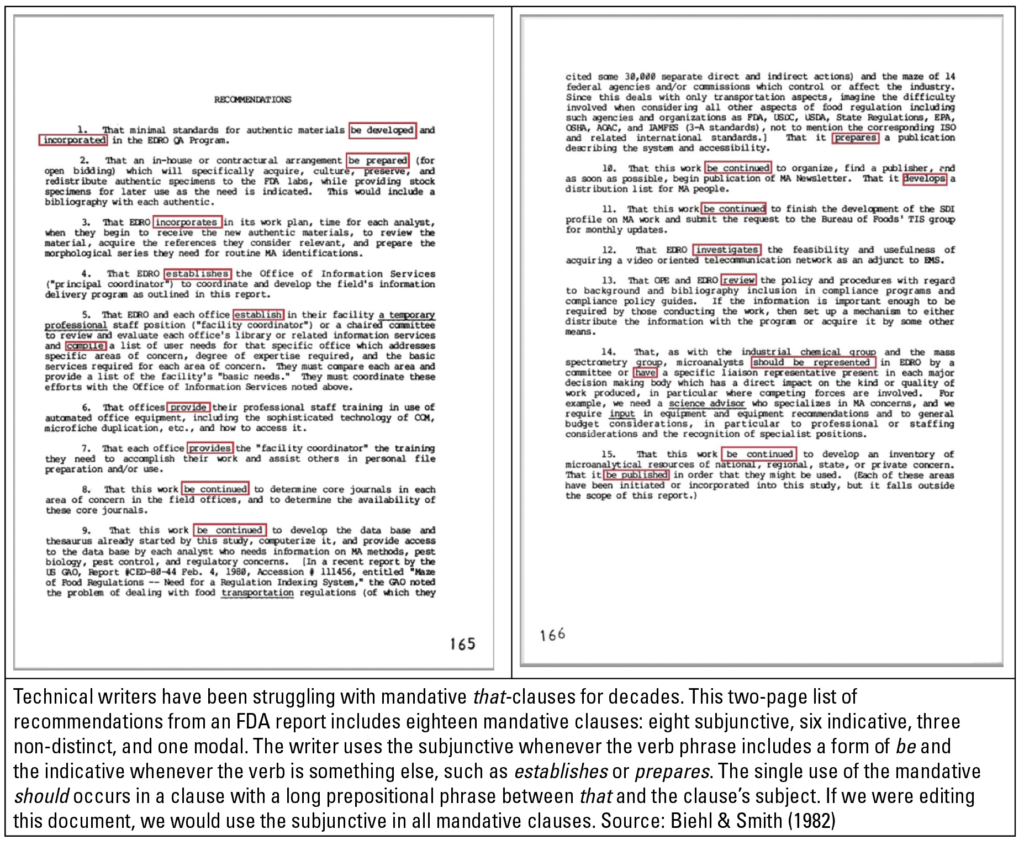 Appendix B: Inconsistent Use of the Mandative Subjunctive
Appendix B: Inconsistent Use of the Mandative Subjunctive
[1] The technical terms for real and unreal are realis and irrealis.
[2] Studies of the inflectional or morphological subjunctive in English linguistics include Auer (2008); Berg, Zingler, and Lohmann (2020); Crawford (2009); Deshors and Gries (2020): Hundt (2018); Hundt, Hoffman, and Mukherjee (2012); Kastronic and Poplack (2014); Kjellmer (2009); Övergaard (1995); Peters (1998); Schluter (2009); Schneider (2011); Serpollet (2011), and Waller (2017).
[3] “Broadly speaking, there are two types of grammarians: prescriptivists and descriptivists. A prescriptivist, a grammarian who has an agenda and takes a hard line on rules, is far more likely to find errors in tense and aspect [and mood] than a descriptivist, a grammarian who is mainly interested in how people use language and is tolerant of—and even pleased by—variance” (Cunningham, Malone, & Rothschild, 2019, p. 328).
[4] It is an etymological fallacy to assume that a mandative that-clause expresses a mandate. Sometimes mandative that-clauses express mandates relatively directly (e.g., I insist you stay) or indirectly (e.g., He insisted she stay), but other times they do not express “mandates” at all (e.g., I’d prefer she go with you if you don’t mind). Most of the time, they express indirect directives: “Go with me” becomes “I’d prefer she go with me” or “They’re insisting she go with me.”
[5] Although Markel’s textbook was available in a 13th edition (Markel & Selber, 2021) at the time of our writing, we used the 9th edition (Markel, 2010) because we had access to a searchable digital scan of that edition via archive.org.
[6] As a reminder, “we” refers to the authors, Malone and Roberson.



